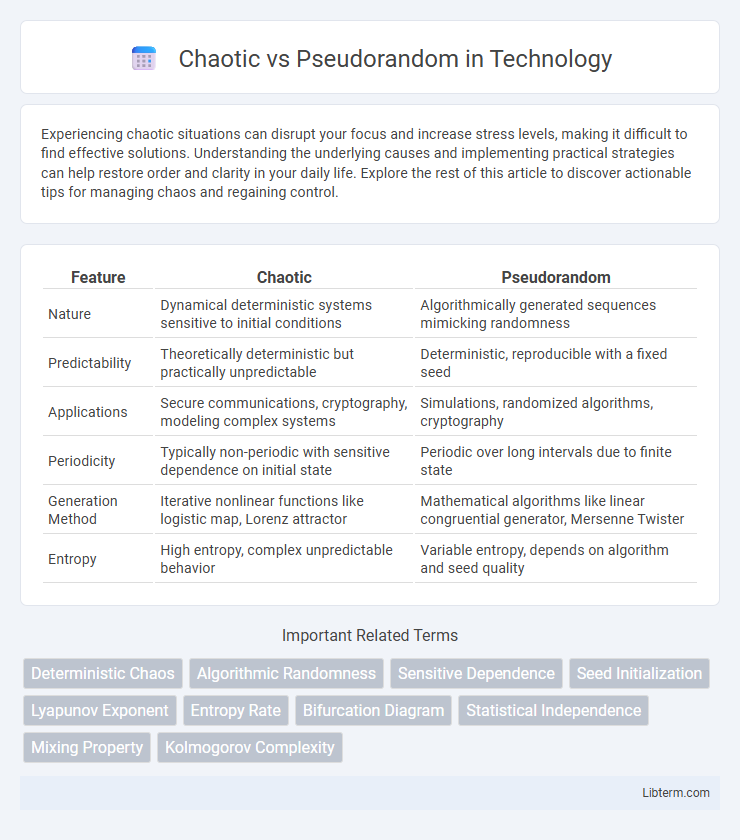Experiencing chaotic situations can disrupt your focus and increase stress levels, making it difficult to find effective solutions. Understanding the underlying causes and implementing practical strategies can help restore order and clarity in your daily life. Explore the rest of this article to discover actionable tips for managing chaos and regaining control.
Table of Comparison
| Feature | Chaotic | Pseudorandom |
|---|---|---|
| Nature | Dynamical deterministic systems sensitive to initial conditions | Algorithmically generated sequences mimicking randomness |
| Predictability | Theoretically deterministic but practically unpredictable | Deterministic, reproducible with a fixed seed |
| Applications | Secure communications, cryptography, modeling complex systems | Simulations, randomized algorithms, cryptography |
| Periodicity | Typically non-periodic with sensitive dependence on initial state | Periodic over long intervals due to finite state |
| Generation Method | Iterative nonlinear functions like logistic map, Lorenz attractor | Mathematical algorithms like linear congruential generator, Mersenne Twister |
| Entropy | High entropy, complex unpredictable behavior | Variable entropy, depends on algorithm and seed quality |
Understanding Chaos and Pseudorandomness
Chaos theory studies deterministic systems highly sensitive to initial conditions, producing complex and seemingly random behavior despite underlying order. Pseudorandomness refers to sequences generated by algorithms that mimic randomness but are entirely deterministic and reproducible. Understanding chaos involves exploring nonlinear dynamics and attractors, while pseudorandomness relies on computational methods and seed values to simulate stochastic processes.
Defining Chaotic Systems
Chaotic systems are deterministic processes characterized by extreme sensitivity to initial conditions, leading to seemingly random and unpredictable behavior despite being governed by deterministic rules. These systems exhibit nonlinear dynamics and fractal structures, making long-term prediction virtually impossible even though the underlying system is non-random. In contrast, pseudorandom sequences are algorithmically generated to mimic randomness but lack the inherent unpredictability and complex patterns found in chaotic systems.
What is Pseudorandomness?
Pseudorandomness refers to sequences of numbers that appear random but are generated by deterministic algorithms, known as pseudorandom number generators (PRNGs). These sequences pass various statistical tests for randomness but are reproducible if the initial seed value is known. Unlike true randomness derived from physical processes, pseudorandomness is essential for applications in simulations, cryptography, and algorithmic processes where controlled unpredictability is required.
Mathematical Foundations: Chaos vs Pseudorandomness
Chaos theory examines deterministic systems highly sensitive to initial conditions, producing complex and seemingly unpredictable behavior governed by nonlinear dynamics and fractal geometry. Pseudorandomness relies on algorithmic processes generating sequences that mimic true randomness, founded on number theory and computational complexity for reproducibility and statistical uniformity. The mathematical distinction lies in chaos emphasizing continuous dynamical systems with sensitive dependence, while pseudorandomness focuses on discrete algorithms designed to approximate randomness efficiently.
Key Differences Between Chaotic and Pseudorandom Processes
Chaotic processes exhibit deterministic behavior with sensitivity to initial conditions, resulting in complex but predictable patterns over time, whereas pseudorandom processes generate sequences through algorithms designed to mimic randomness despite being internally deterministic. Key differences include the origin of unpredictability: chaos arises from nonlinear dynamical systems while pseudorandomness is based on computational algorithms such as linear congruential generators or cryptographic functions. Chaotic sequences are highly correlated and sensitive to initial states, whereas pseudorandom sequences prioritize statistical randomness and repeatability for cryptographic and simulation purposes.
Applications of Chaotic Systems
Chaotic systems find extensive applications in secure communications by generating complex, unpredictable signals that enhance encryption robustness. In engineering, they are utilized for optimizing control systems and improving signal processing through their sensitive dependence on initial conditions. Biological modeling leverages chaotic dynamics to simulate heart rhythms and neural activity, providing insights into complex physiological processes.
Uses of Pseudorandom Sequences
Pseudorandom sequences are extensively used in cryptography for secure key generation and encryption algorithms, ensuring data confidentiality. They play a critical role in simulations and modeling, providing reproducible randomness essential for scientific experiments and system testing. Additionally, these sequences are fundamental in randomized algorithms and digital communications for error detection and correction mechanisms.
Advantages and Limitations of Each Approach
Chaotic systems generate sequences with high sensitivity to initial conditions, offering true unpredictability beneficial for secure communications but are limited by their dependence on precise system parameters and potential for deterministic patterns. Pseudorandom number generators (PRNGs) provide reproducible sequences ideal for simulations and cryptographic applications requiring repeatability, yet they risk predictability if the algorithm or seed is compromised. Each approach balances unpredictability and repeatability differently, influencing their suitability for various cryptographic and modeling tasks.
Real-World Examples: Chaotic vs Pseudorandom
Chaotic systems such as weather patterns and double pendulums exhibit deterministic chaos where small differences in initial conditions lead to vastly different outcomes, making long-term prediction difficult despite the underlying determinism. Pseudorandom sequences used in computer algorithms, like the Mersenne Twister or linear congruential generators, produce reproducible outputs that simulate randomness but are governed by deterministic initial seeds. Real-world applications of chaotic systems include modeling climate dynamics, while pseudorandomness is essential in cryptography, simulations, and gaming where predictable yet complex sequences are required.
Choosing Between Chaotic and Pseudorandom Methods
Choosing between chaotic and pseudorandom methods depends on the application's need for unpredictability and reproducibility. Chaotic systems generate deterministic yet highly sensitive outputs ideal for encryption or complex simulations requiring high entropy, while pseudorandom methods offer reproducible sequences suited for algorithm testing and statistical modeling. Evaluating system requirements for sensitivity to initial conditions, computational efficiency, and control over randomness guides the optimal choice between chaotic and pseudorandom approaches.
Chaotic Infographic

 libterm.com
libterm.com